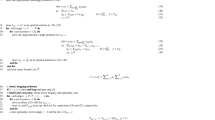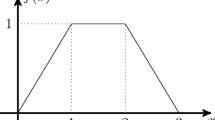Abstract
We propose a nested decomposition scheme for infinite-horizon stochastic linear programs. Our approach can be seen as a provably convergent extension of stochastic dual dynamic programming to the infinite-horizon setting: we explore a sequence of finite-horizon problems of increasing length until we can guarantee convergence with a given confidence level. The methodology alternates between a forward pass to explore sample paths and determine trial solutions, and a backward pass to generate a polyhedral approximation of the optimal value function by computing subgradients from the dual of the scenario subproblems. A computational study on a large set of randomly generated instances for two classes of problems shows that the proposed algorithm is able to effectively solve instances of moderate size to high precision, provided that the instance structure allows the construction of what we call constant-statepolicies with satisfactory objective function value.

Similar content being viewed by others
Notes
To be precise, the value of the optimal policy for \(P_{T(\epsilon )}\) can be found by solving (VF-L0-0), the remaining problems (VF-Lt-j) are used to identify the optimal policy.
In this proof, an iteration is an execution of a forward pass and a backward pass on a sample path; this allows us a few simplifications when adapting parts of [14] to our setting.
Recall that our iterations include a full backward pass; hence they include the steps between \(k\tau \) and \((k+1)\tau -1\) in [14].
References
Asamov, T., Powell, W.B.: Regularized decomposition of high-dimensional multistage stochastic programs with markov uncertainty. SIAM J. Optim. 28(1), 575–595 (2018)
Bellman, R.: Dynamic Programming. Princeton University Press, Princeton, NJ (1957)
Bertsekas, D.P.: Dynamic Programming and Optimal Control. Athena Scientific, Belmont, MA (1995)
Bertsimas, D., Tsitsiklis, J.: Introduction to Linear Optimization. Athena Scientific, Belmont (1997)
Birge, J.R.: Decomposition and partitioning methods for multistage stochastic linear programs. Oper. Res. 33(5), 989–1007 (1985)
Birge, J.R., Louveaux, F.: Introduction to Stochastic Programming. Springer Science & Business Media, Berlin (2011)
Birge, J.R., Louveaux, F.V.: A multicut algorithm for two-stage stochastic linear programs. Eur. J. Oper. Res. 34(3), 384–392 (1988)
de Matos, V.L., Philpott, A.B., Finardi, E.C.: Improving the performance of stochastic dual dynamic programming. J. Comput. Appl. Math. 290, 196–208 (2015)
Donohue, C., Birge, J.R.: The abridged nested decomposition method for multistage stochastic linear programs with relatively complete recourse. Algorithm. Oper. Res. 1(1), (2006)
Duffin, R.J., Karlovitz, L.A.: An infinite linear program with a duality gap. Manage. Sci. 12(1), 122–134 (1965)
Gassmann, H.I.: Mslip: A computer code for the multistage stochastic linear programming problem. Math. Program. 47(1), 407–423 (1990)
Ghate, A., Smith, R.: Optimal backlogging over an infinite horizon under time-varying convex production and inventory costs. Manuf. Serv. Oper. Manag. 11(2), 362–368 (2009)
Girardeau, P., Leclere, V., Philpott, A.B.: On the convergence of decomposition methods for multistage stochastic convex programs. Math. Oper. Res. 40(1), 130–145 (2014)
Grinold, R.C.: Finite horizon approximations of infinite horizon linear programs. Math. Program. 12(1), 1–17 (1977)
Guigues, V.: SDDP for some interstage dependent risk-averse problems and application to hydro-thermal planning. Comput. Optim. Appl. 57(1), 167–203 (2014)
Heitsch, H., Römisch, W.: Scenario tree modeling for multistage stochastic programs. Math. Program. 118(2), 371–406 (2009)
Infanger, G., Morton, D.P.: Cut sharing for multistage stochastic linear programs with interstage dependency. Math. Program. 75(2), 241–256 (1996)
Kelley, J.E.: The cutting-plane method for solving convex programs. J. Soc. Ind. Appl. Math. 8(4), 703–712 (1960)
Kim, K., Mehrotra, S.: A two-stage stochastic integer programming approach to integrated staffing and scheduling with application to nurse management. Oper. Res. 63(6), 1431–1451 (2015)
Laporte, G., Meunier, F., Wolfler Calvo, R.: Shared mobility systems. 4OR 13(4), 341–360 (2015)
Martello, S., Toth, P.: Knapsack Problems: Algorithms and Computer Implementations. Wiley, New York, NY (1990)
Mulvey, J.M., Vladimirou, H.: Solving multistage stochastic networks: an application of scenario aggregation. Networks 21(6), 619–643 (1991)
Mulvey, J.M., Vladimirou, H.: Stochastic network programming for financial planning problems. Manage. Sci. 38(11), 1642–1664 (1992)
Pereira, M., Pinto, L.: Multi-stage stochastic optimization applied to energy planning. Math. Program. 52(1–3), 359–375 (1991)
Pfeiffer, L., Apparigliato, R., Auchapt, S.: Two methods of pruning Benders’ cuts and their application to the management of a gas portfolio. Tech. Rep. 8133, INRIA (2012)
Powell, W.B.: Approximate Dynamic Programming: Solving the Curses of Dimensionality, 2nd edn. Wiley, New York (2011)
Romeijn, E.H., Smith, R.L., Bean, J.C.: Duality in infinite dimensional linear programming. Math. Program. 53(1–3), 79–97 (1992)
Schochetman, I.E., Smith, R.L.: Finite dimensional approximation in infinite dimensional mathematical programming. Math. Program. 54(1–3), 307–333 (1992)
Shapiro, A.: Analysis of stochastic dual dynamic programming method. Eur. J. Oper. Res. 209(1), 63–72 (2011)
Van Slyke, R.M., Wets, R.: L-shaped linear programs with applications to optimal control and stochastic programming. SIAM J. Appl. Math. 17(4), 638–663 (1969)
Zenios, S.A.: Financial Optimization. Cambridge University Press, Cambridge (1993)
Zhang, W.: Water Network Design and Management via Stochastic Programming. The University of Arizona, Arizona (2013)
Zou, J., Ahmed, S., Sun, X.A.: Nested decomposition of multistage stochastic integer programs with binary state variables. Tech. rep., Georgia Institute of Technology (2016). http://www.optimization-online.org/DB_HTML/2016/05/5436.html
Author information
Authors and Affiliations
Corresponding author
Additional information
Publisher's Note
Springer Nature remains neutral with regard to jurisdictional claims in published maps and institutional affiliations.
A computational tests with different values of \(\delta \)
A computational tests with different values of \(\delta \)
In Table 5 we show the details about the computation times of the different algorithms when \(\delta \) increases.
Rights and permissions
About this article
Cite this article
Nannicini, G., Traversi, E. & Calvo, R.W. A Benders squared (\(B^2\)) framework for infinite-horizon stochastic linear programs. Math. Prog. Comp. 13, 645–681 (2021). https://doi.org/10.1007/s12532-020-00195-2
Received:
Accepted:
Published:
Issue Date:
DOI: https://doi.org/10.1007/s12532-020-00195-2




